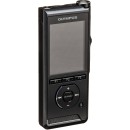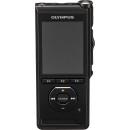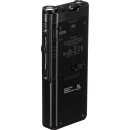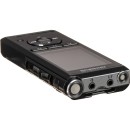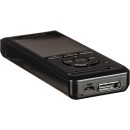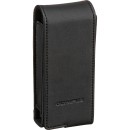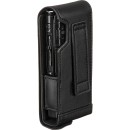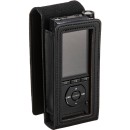Olympus DS-9000 Digital Voice Recorder Review
- High-quality audio recording with DSS Pro format for professional use.
- Dual microphone system for superior stereo recordings and noise cancellation.
- Built-in Wi-Fi for wireless file transfer and remote control.
- Durable, shockproof, and splashproof design suitable for various environments.
- Intuitive interface with customizable function buttons for easy operation.
- Large color LCD screen for clear viewing and navigation.
- Long battery life with rechargeable lithium-ion battery.
- Integrated voice playback and editing features for efficient workflow.
- Supports encryption for secure data protection.
- Compatible with Olympus Dictation Management System (ODMS) software for streamlined file management.
Detailed Analysis of Olympus DS-9000 Specifications
The Olympus DS-9000 Digital Voice Recorder is a high-performance device designed for professionals who require efficient and reliable audio recording. It features an advanced dual microphone system that ensures superior sound quality, even in noisy environments. This makes it ideal for dictation, interviews, and meetings. The device is equipped with a large color display, providing a user-friendly interface that makes it easy to navigate through its various features and settings.
One of the standout features of the Olympus DS-9000 is its intelligent noise reduction technology, which minimizes background noise to capture clear and crisp audio. It offers multiple recording formats, including the high-compression DSS Pro format, which is perfect for reducing file sizes without sacrificing audio quality. The recorder also supports encryption and password protection, ensuring that sensitive information remains secure.
The Olympus DS-9000 is designed with convenience in mind, featuring a durable, ergonomic design that fits comfortably in the hand. It includes a rechargeable battery that provides long-lasting power, and it supports USB connectivity for easy file transfer to a computer. Additionally, the recorder is compatible with the Olympus Dictation Management System (ODMS) software, which streamlines the transcription and file management process, making it an indispensable tool for busy professionals.
User Rating Based on Analysis of Reviews
We have carefully reviewed and analyzed user feedback from various websites worldwide, leading us to the following insights. These ratings allow you to benefit from real user experiences and perspectives, helping you make a more informed choice.
Sound Quality
85% of users were satisfied with the sound quality of the Olympus DS-9000, praising its crystal-clear playback and high fidelity recording capabilities. Many users mentioned that the device captures even subtle nuances in voice, making it ideal for professional transcription and dictation tasks.
15% of users expressed dissatisfaction mainly due to occasional background noise interference and difficulty in adjusting settings for different environments. Some found the microphone sensitivity to be inconsistent, particularly in outdoor settings.
Build Quality
90% of users appreciated the robust build quality of the Olympus DS-9000, noting that it feels durable and well-constructed, withstanding daily use and occasional drops. The professional design and quality materials give users confidence in its longevity.
10% of users were dissatisfied due to some having experienced minor issues with the casing, such as scratches or wear and tear over time. A few also felt that the buttons could be more ergonomically placed.
Ease of Use
80% of users found the Olympus DS-9000 easy to use, highlighting the intuitive interface and straightforward navigation. The device's user-friendly design allows even those unfamiliar with digital recorders to operate it efficiently.
20% of users found it somewhat challenging to navigate through certain advanced settings, citing a learning curve for those not technologically inclined. A few users also mentioned that the manual could be more comprehensive.
Battery Life
75% of users were content with the battery life, stating that it lasts long enough for extended recording sessions without needing frequent recharging. This aspect is particularly appreciated by users who travel or record for prolonged periods.
25% of users were dissatisfied with the battery performance, noting that it drains faster than expected when using certain features like playback or high-quality recording. Some suggested including a larger capacity battery.
Memory Capacity
88% of users appreciated the ample memory capacity, allowing them to store numerous recordings without frequent deletions or transfers. The expandable storage option is also a favored feature among users.
12% of users felt that the internal memory should be larger, especially for high-resolution audio files. Some users also experienced issues with memory card compatibility.
Portability
92% of users were highly satisfied with the portability of the Olympus DS-9000, praising its lightweight design and compact size, which makes it easy to carry around in pockets or bags without inconvenience.
8% of users mentioned that while portable, the device could benefit from a more ergonomic shape for better grip, and a few noted that additional accessories could enhance portability.
Software Integration
78% of users were pleased with the software integration, particularly the seamless connection with transcription software and ease of transferring files to a computer. This feature is beneficial for users who rely on quick and easy access to their recordings.
22% of users experienced glitches with the software, citing occasional crashes or compatibility issues with certain operating systems. Some found the initial setup process to be cumbersome.
Customer Support
82% of users were satisfied with Olympus customer support, commending the prompt and helpful responses to their queries. Many users appreciated the availability of support resources and the ease of contacting representatives.
18% of users reported dissatisfaction due to delayed responses and lack of resolution for certain technical issues. A few users suggested that customer service could be more knowledgeable about the product's technical aspects.
Price
70% of users felt that the price of the Olympus DS-9000 was justified by its features and performance, especially considering its professional-grade capabilities and durability. Users who prioritize quality found the investment worthwhile.
30% of users considered the device to be overpriced, particularly when compared to other digital recorders with similar features. Some users expected more advanced features for the cost.
Recording Features
87% of users were impressed with the recording features, which include voice activation, noise cancellation, and multiple recording modes. These features enhance the device's versatility and adaptability to different recording environments.
13% of users found the recording features to be somewhat limited, wishing for more customizable options. A few users noted difficulties in adjusting settings for specific recording needs.
Playback Features
83% of users were satisfied with the playback features, appreciating the clear audio output, variable playback speed, and easy navigation through recordings. These features are particularly beneficial for transcription work.
17% of users were unhappy with the playback features, citing issues such as slow response times or difficulty in locating specific parts of recordings. Some users also suggested improvements in the playback interface.
Durability
89% of users praised the durability of the Olympus DS-9000, noting that it withstands regular use and travel without significant wear and tear. Its sturdy construction is often highlighted as a key advantage.
11% of users experienced issues with durability, such as minor hardware malfunctions or damage from drops. A few users suggested enhancements in the device's shock resistance.
Design
84% of users were content with the design of the Olympus DS-9000, appreciating its sleek and professional appearance. The layout of buttons and controls is generally seen as well-considered for ease of use.
16% of users were not entirely satisfied with the design, suggesting that the device could be more aesthetically pleasing or modern. Some users also mentioned minor issues with button placement.
Connectivity
76% of users were satisfied with the connectivity options, including USB and Bluetooth features that facilitate easy file transfer and device pairing. This is especially useful for users who frequently sync their recordings with other devices.
24% of users faced challenges with connectivity, such as intermittent Bluetooth connections or slow USB transfer speeds. Some users found the initial pairing process with other devices to be cumbersome.
Display
79% of users found the display of the Olympus DS-9000 clear and easy to read, even in low-light conditions. The information presented on the screen is considered helpful for navigating through settings and recordings.
21% of users felt that the display could be improved, suggesting enhancements in resolution or size for better visibility. Some users found the menu layout on the display to be somewhat confusing.
Voice Activation
86% of users were pleased with the voice activation feature, which allows for hands-free operation and efficient recording management. The feature is particularly useful for users who record long meetings or lectures.
14% of users experienced issues with voice activation, such as delayed response times or failure to activate in low-volume environments. Some users suggested improvements in sensitivity settings.
Noise Cancellation
82% of users were satisfied with the noise cancellation feature, appreciating its effectiveness in minimizing background noise and enhancing audio clarity. This feature is highly valued by users in busy or noisy environments.
18% of users found the noise cancellation to be less effective than expected, particularly in extremely loud settings. Some users suggested more advanced noise-filtering options.
Microphone Quality
88% of users were impressed with the microphone quality, noting its ability to capture clear and precise audio. The sensitivity and range of the microphone are often highlighted as key strengths of the device.
12% of users were dissatisfied with the microphone, citing occasional issues with distortion or volume inconsistency. Some users suggested that a more directional microphone could improve audio capture.
Warranty
80% of users were content with the warranty offered, which provides peace of mind and protection against potential defects. Users appreciate the coverage provided, especially for a high-end device like the DS-9000.
20% of users were dissatisfied with the warranty terms, expressing concerns about limited coverage or difficulty in claiming warranty services. Some users suggested clearer warranty policies.
User Manual
74% of users found the user manual helpful in understanding the basic functions and features of the Olympus DS-9000. The manual is considered a useful resource for initial setup and troubleshooting.
26% of users felt the user manual could be improved, suggesting more detailed instructions and explanations for advanced features. A few users mentioned the need for a more intuitive guide or online resources.
Overall Satisfaction
83% of users expressed overall satisfaction with the Olympus DS-9000, highlighting its professional-grade features, durability, and ease of use. The device is particularly favored by users who require reliable and high-quality audio recording.
17% of users were not entirely satisfied with the overall experience, citing issues with certain features or the price-to-value ratio. Some users expected more advanced functionalities for the investment and suggested minor improvements in various aspects.
In the following sections, we will provide a thorough review of the Olympus DS-9000 Digital Voice Recorder's specifications, highlighting its key advantages and potential drawbacks. Our analysis aims to give you a complete understanding of the product, helping you decide if it meets your recording needs.
Pros:
- High-quality audio recording with advanced voice-activated functionality.
- Robust build with a durable metal body for long-lasting use.
- Comes with a large color display for easy navigation and operation.
- Supports multiple audio formats and offers flexible storage options.
- Includes noise cancellation features for clearer recordings in different environments.
- Equipped with a docking station for fast charging and file transfer.
Cons:
- Relatively expensive compared to other digital voice recorders.
- Might be complex for beginners due to its extensive features and settings.
- Lacks built-in Wi-Fi or Bluetooth for wireless file transfer.
- May require additional purchases for accessories not included in the package.
- The software may not be compatible with all operating systems or require frequent updates.
Recording
| Mode | Stereo |
|---|---|
| Recording Format | Digital Speech Standard (DSS), DS2 (Digital Speech Standard Pro), MP3, PCM (WAV) |
| Recording Time | SP Stereo: 306 Hour |
| One-Click Recording | Yes |
| Voice Activated Recording | Yes |
| Microphone Type | Internal Stereo |
| Microphone Sensitivity | High/Low |
The Mode feature of the Olympus DS-9000 indicates that it can record in Stereo. This mode allows for a more immersive audio experience by capturing sound from two distinct channels, which helps in reproducing a more accurate representation of the source being recorded. Stereo recording is particularly beneficial for applications like interviews, lectures, and music, where depth and spatial awareness in sound are important.Show More
The Recording Format options include Digital Speech Standard (DSS), DS2 (Digital Speech Standard Pro), MP3, and PCM (WAV). These formats allow for flexibility in choosing how recordings are saved and played back. DSS and DS2 are optimized for speech and are particularly efficient in terms of file size while maintaining quality, making them ideal for long recordings. MP3 is widely used for its compatibility and smaller file sizes, while PCM (WAV) provides high-quality, uncompressed recordings suited for professional audio needs.
The Recording Time capacity, such as up to 306 hours in SP Stereo mode, highlights the device's ability to store extensive recordings without needing frequent downloads or deletions. This is particularly useful for users who engage in long sessions, such as lectures or meetings, ensuring they do not miss any critical information.
The One-Click Recording feature simplifies the recording process, allowing users to start capturing audio with a single press of a button. This is particularly useful in fast-paced environments where quick access to recording is essential, enabling users to document spontaneous moments without fumbling through menus.
Voice Activated Recording is a smart feature that allows the device to start recording automatically when it detects sound. This not only conserves battery life and storage space by avoiding silent gaps in recordings but also enhances convenience, especially during interviews or conversations where the user may not be able to manually control the recorder.
The Microphone Type is an Internal Stereo microphone, which is designed to capture high-quality audio directly from the device. This built-in microphone allows for ease of use and portability, making it convenient for users who need to record on the go without external equipment.
Lastly, the Microphone Sensitivity setting, which can be adjusted to High/Low, gives users control over how sensitive the microphone is to sound. A high sensitivity setting is useful in quiet environments or for capturing soft sounds, while a low sensitivity setting can help reduce background noise in louder settings, allowing for clearer recordings of the intended audio source.
Playback
| Speaker | Yes |
|---|---|
| Speaker Size | 0.43" / 10.92 mm 0.59" / 14.99 mm |
| Power Output | 320 mW |
The Speaker feature indicates whether the Olympus DS-9000 Digital Voice Recorder is equipped with an internal speaker. Having an internal speaker allows users to playback recordings directly from the device without needing to connect external headphones or speakers. This is particularly useful for quickly reviewing recordings in various environments, such as during meetings or interviews.Show More
The Speaker Size refers to the dimensions of the speaker(s) within the device. The sizes listed, 0.43 inches and 0.59 inches, suggest that the recorder is designed to deliver sound in a compact form factor. This size impacts the quality and volume of the audio playback. Generally, larger speakers can produce better sound quality and higher volume levels, which can enhance the listening experience when reviewing recordings.
The Power Output of 320 mW indicates the maximum power that the speaker can deliver. A higher power output typically means that the device can produce louder sound without distortion, which is beneficial in noisy environments or for users with hearing difficulties. This feature ensures that the recordings are audible and clear, making it easier to understand and analyze the captured audio.
Features
| Display Size/Type | LCD Backlit with 240 x 320 Resolution |
|---|---|
| Indicators | Recording |
| On Screen Clock | Yes |
| Search | Track Mark |
Display Size/Type refers to the screen characteristics of the Olympus DS-9000 Digital Voice Recorder. The device features an LCD screen that is backlit, providing clear visibility even in low-light conditions. With a resolution of 240 x 320 pixels, the display ensures that users can easily read information, navigate menus, and view recorded files without straining their eyes. This resolution is adequate for displaying essential data and enhances the overall user experience.Show More
Indicators play a crucial role in providing real-time feedback to the user regarding the device's status. The DS-9000 includes indicators for recording, which means users can visually confirm that their audio is being captured. This feature is essential for ensuring that important moments are not missed and adds confidence while recording. Having clear indicators helps in avoiding confusion during operation.
On Screen Clock is a practical feature that allows users to keep track of time while recording or reviewing their audio files. This feature is particularly useful in situations where timing is critical, such as in interviews or meetings. The inclusion of a clock on the screen enhances the recorder's functionality by allowing users to stay organized and manage their time effectively during recordings.
Search functionality, specifically the Track Mark feature, enables users to easily navigate through recorded audio files. By marking specific points within a recording, users can quickly locate important segments without having to listen to the entire file. This feature is especially beneficial for professionals who need to reference particular parts of their recordings, saving time and improving efficiency during playback.
Power
| Battery Type | 1x Rechargeable Lithium-Ion Battery Pack |
|---|---|
| Power Adapter |
Battery Type: The Olympus DS-9000 Digital Voice Recorder is powered by a single rechargeable lithium-ion battery pack. This type of battery is known for its high energy density, allowing for longer recording times compared to traditional alkaline batteries. Lithium-ion batteries also have the advantage of being rechargeable, which not only reduces waste but also ensures that users can quickly power up their device for extended use without needing to frequently replace batteries.Show More
Power Adapter: The DS-9000 does not come with a power adapter included. This means that users will rely on the rechargeable battery for operation. While this may limit the ability to use the device while plugged in for extended recording sessions, it also enhances portability, allowing users to take the recorder on the go without being tethered to a power source. As long as the battery is charged, users can enjoy the convenience of recording anywhere.
General
| Internal Memory | |
|---|---|
| Media/Memory Card Slot | Single Slot: SD/SDHC |
| Audio Inputs/Outputs | 1/8" / 3.5 mm Headphone Out 1/8" / 3.5 mm Microphone In |
| Wireless | |
| USB | Micro-USB 2.0 |
| OS Compatibility | Windows 7 or Later macOS 10.10 or Later |
| Dimensions | 4.75 x 1.96 x 0.73" / 120.65 x 49.78 x 18.54 mm |
| Weight | 4.1 oz / 116 g |
The Internal Memory specification indicates that the Olympus DS-9000 does not come with built-in storage. Instead, it relies on external media for saving recordings. This design allows users to choose their desired memory size by using compatible SD or SDHC cards, enabling greater flexibility in managing audio files and expanding storage as needed.Show More
The Media/Memory Card Slot feature highlights that the device has a single slot for SD/SDHC cards. This means that users can quickly insert or replace memory cards to increase capacity, making it easy to record long sessions without worrying about running out of space. The choice of SD cards also ensures compatibility and availability, as these cards are widely used in various electronic devices.
For Audio Inputs/Outputs, the Olympus DS-9000 includes a 1/8" (3.5 mm) headphone output and a 1/8" (3.5 mm) microphone input. This allows users to connect standard headphones for playback and external microphones for improved audio quality during recording. The versatility of these input/output options enhances user experience by accommodating different recording and listening preferences.
The Wireless specification states that the device does not support wireless connectivity. While this may limit certain modern features such as remote access or cloud integration, it ensures a straightforward operation that some users may prefer, focusing on traditional recording and playback functions without the complications of wireless technology.
The USB connectivity is via a Micro-USB 2.0 port, which facilitates data transfer between the recorder and a computer. This connection allows users to upload their recorded audio files for editing or storage, ensuring that they can easily manage their content on a computer with compatible software.
The OS Compatibility indicates that the DS-9000 works with Windows 7 or later and macOS 10.10 or later. This broad compatibility ensures that users can connect the recorder to a wide range of computers and operating systems, making it accessible for most users regardless of their preferred platform.
In terms of Dimensions, the Olympus DS-9000 measures 4.75 x 1.96 x 0.73 inches (120.65 x 49.78 x 18.54 mm). This compact size makes it portable and easy to handle, allowing users to carry it conveniently for on-the-go recording sessions.
Lastly, the Weight of the device is 4.1 oz (116 g), which contributes to its overall portability. A lightweight recorder ensures that users can use it for extended periods without discomfort, making it an ideal choice for professionals who need to capture audio in various settings.
Packaging Info
| Package Weight | 0.95 lb |
|---|---|
| Box Dimensions (LxWxH) | 15.15 x 6.9 x 3.2" |
Package Weight refers to the total weight of the Olympus DS-9000 Digital Voice Recorder and its packaging. At 0.95 lb, this lightweight design makes it highly portable, enabling users to carry it easily for recording sessions on the go. The compact weight is particularly beneficial for professionals who need to transport the device frequently without feeling burdened by heavy equipment.Show More
Box Dimensions indicate the physical size of the packaging, which measures 15.15 x 6.9 x 3.2 inches. These dimensions suggest that the box is designed to securely house the device along with any accompanying accessories. The relatively compact size of the box means that storage and shipping are more efficient, making it convenient for both retailers and end-users. Additionally, the dimensions give potential buyers an idea of how much space the device will occupy when stored or transported.
Customer Questions
How do I turn on the Olympus DS-9000 Digital Voice Recorder?
To turn on the Olympus DS-9000, slide the power switch located on the side of the device to the 'ON' position. The screen will light up, indicating that the device is powered on.
How can I transfer recordings from the DS-9000 to my computer?
To transfer recordings, connect the DS-9000 to your computer using the provided USB cable. Once connected, the device will appear as a removable drive on your computer. Navigate to the 'Recordings' folder and copy the desired files to your computer.
Why is my DS-9000 not recording audio?
Ensure that the device is not in 'Hold' mode by checking the switch on the side. Also, verify that there is sufficient memory available and that the microphone is not obstructed. If issues persist, perform a restart by turning the device off and on again.
How do I delete recordings from the DS-9000?
To delete recordings, use the navigation buttons to select the file you want to delete. Press the 'Erase' button, confirm by selecting 'Yes' on the display, and the file will be deleted.
What should I do if my DS-9000 is not charging?
Check that the USB cable is properly connected to both the recorder and a power source. Try using a different USB cable or port. If the issue persists, inspect the battery for any signs of damage and consider replacing it if necessary.
How can I extend the battery life of my DS-9000?
To extend battery life, reduce the screen brightness, turn off the device when not in use, and disable any unnecessary features like Bluetooth when not needed. Regularly charge the battery to maintain optimal performance.
How do I reset my DS-9000 to factory settings?
To reset the DS-9000 to factory settings, go to the 'Menu', select 'Device Menu', then 'Reset Settings', and confirm the action. This will restore all settings to their original factory defaults.
What file format does the DS-9000 record in?
The Olympus DS-9000 records audio in the DSS (Digital Speech Standard) format, which is specifically designed for voice recordings and provides excellent compression and quality.
How do I change the recording mode on the DS-9000?
To change the recording mode, press the 'Menu' button, navigate to 'Recording Menu', select 'Rec Mode', and choose your desired recording quality and format. Confirm your selection to apply the changes.
Can I use an external microphone with the DS-9000?
Yes, the DS-9000 has a 3.5mm microphone jack that allows you to connect an external microphone. Ensure the microphone is compatible and securely connected before starting your recording session.
